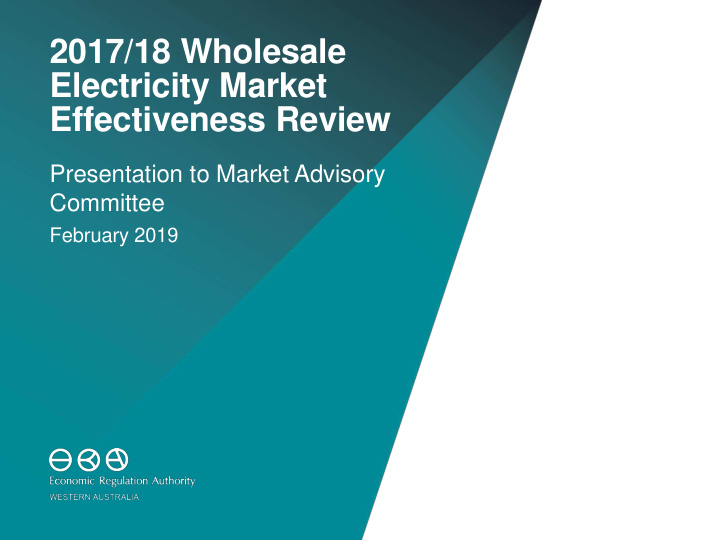



2017/18 Wholesale Electricity Market Effectiveness Review Presentation to Market Advisory Committee February 2019
The high level picture • Things should be good – Excess capacity – Lowest gas prices in real terms in five years and only modest price increases in coal – Low demand, mild summers and solar taking some of the load • But what we see – High balancing prices – Highest ancillary services costs per unit output in the country – Efficiency gains on the administrative side countered by increases in market based costs – Limited competition and substantial market dominance • Limited net gain to consumers over the last few years 2
The high level picture $250 $225 $19 $18 $200 Notional cost ($/MWh $2018 real) $175 $91 $92 $98 $150 $97 $99 $98 $125 $100 $38 $32 $61 $66 $75 $37 $41 $5.03 $5.80 $3.14 $50 $3.10 $3.96 $5.46 $61 $57 $53 $25 $47 $44 $39 $- 2012/13 2013/14 2014/15 2015/16 2016/17 2017/18 Carbon price adjusted energy cost ($/MWh real) Average notional ancillary services costs ($/MWh real) Average notional capacity costs ($/MWh real) Average notional network cost ($/MWh Real) Carbon pricing mechanism ($/MWh real) Market administration ($/MWh real) 3
Fuel prices 1.8 1.6 1.4 1.2 Energy price index 1.0 0.8 0.6 0.4 0.2 0.0 2012/13 2013/14 2014/15 2015/16 2016/17 2017/18 Electricity Coal Gas 4
Market costs $2.00 $40 $1.75 $35 Market administration costs ($millions, $2018 real) $1.50 $30 Market fees ($/MWh $2018 real) $1.25 $25 $1.00 $20 $0.75 $15 $0.50 $10 $0.25 $5 $0.00 $- 2007/08 2008/09 2009/10 2010/11 2011/12 2012/13 2013/14 2014/15 2015/16 2016/17 ERA costs ($2018 real) Market and system operator costs ($2018 real) Total administration cost ($millions, $2018 real) 5
Changes to come • Solar is expected to change the load profile • This is expected to alter how generators run but up to 2017/18: – Coal generators had to move more but output remains comparable with previous years – Couldn’t substantiate suggestions solar is responsible for increases to marginal pricing • Batteries could improve many pressure points in the system and put downward pressure on network, balancing and ancillary service prices • Whether these advantages materialise will depend on the adoption model and whether the substantial first mover advantage is deployed to improve or maintain competition. 6
Conclusions • Lack of competition in the wholesale electricity market fails to provide pressure that would penalise inefficiency • Barriers to entry are not inconsequential and do not appear to be reducing • Opportunities will emerge but there is conjecture as to when • Plenty of policy uncertainty at state and national level, coupled with market dominance, flat growth and inadequate opportunity signals appears to place private investment on the back foot. 7
Questions – Market pricing • What do you consider to be the most important factors driving the price increases and what evidence supports the view? • Are market generators changing bids to recover start-up costs over shorter run times? • Do market mechanisms apply sufficient competitive discipline on generators and what would improve discipline? • Are market administration and development expenditure delivering the anticipated benefits and if not why aren’t they? 8
Questions - New opportunities • Are new technology trials sufficiently open to participation from non-government entities? • Are the planning systems performing as they should at identifying opportunities? If not how could they be improved? • How important is state and national policy uncertainty to the investment environment? • How do changes in distributed generation influence your investment decisions? • When do you anticipate the investment environment improving and what will drive the improvement? 9
Thank you Questions Level 4, 469 Wellington Street, Perth WA 6000 Phone: 08 6557 7900 Email: info@erawa.com.au
Recommend
More recommend